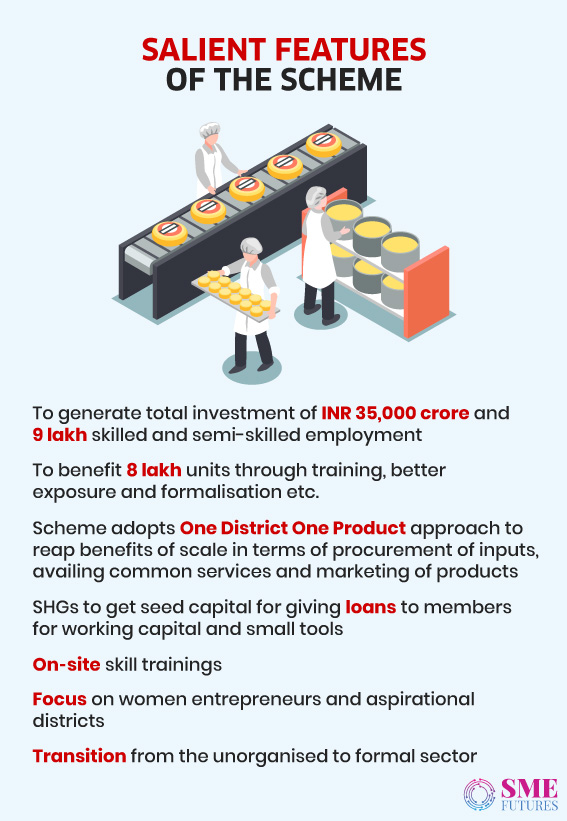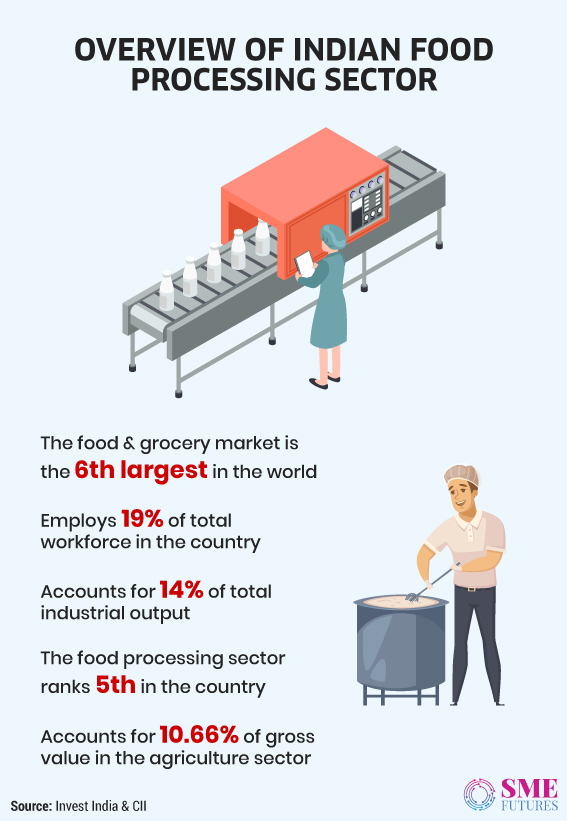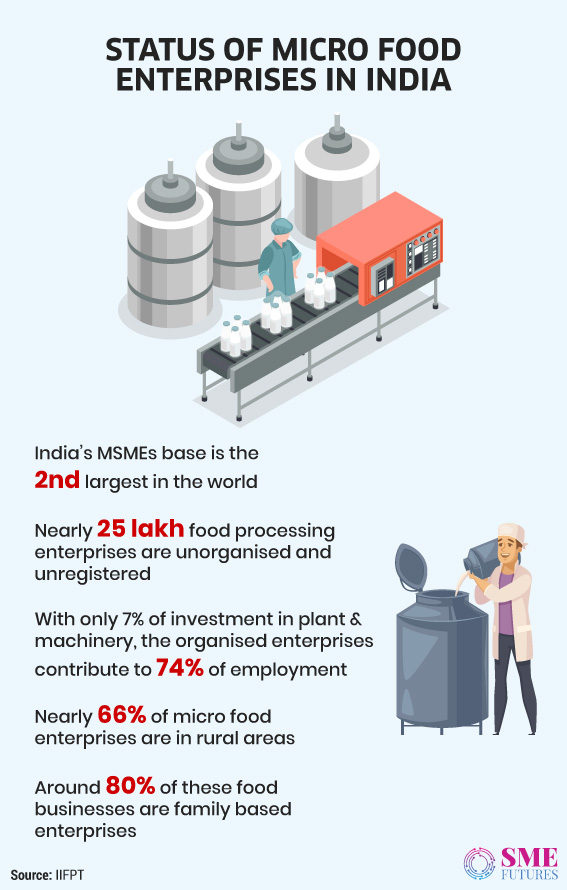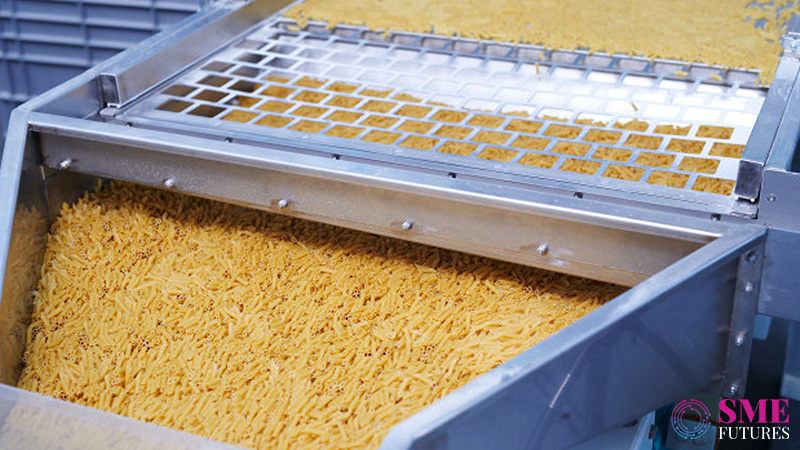Despite the challenges which COVID-19 has posed in front of small businesses, Anand Shah, Owner of Anand Food Products in Jaipur was comparatively relaxed. As many businesses shut their operations during lockdown, Shah’s factory workers were working in full shifts.
Being a manufacturer of wide assortment of processed food items such as papads, badi and pickles, Shah witnessed a high demand of these products during the lockdown. One of the primary reasons behind demand surge in food processing segment was increased consumption and stockpiling.
Speaking about the status of increased demand, Shah confesses, “Since March, it’s been raining orders like never before. When other businesses were down, my workers were working tirelessly. We were even not able to meet some orders. I am currently planning to open a new pasta unit to expand my business.”
Similar to Shah, most of the manufacturers in the food processing sector are trying to increase their production by establishing new units. As a result, government on June 29 launched a Rs 10,000 crore PM Formalisation of Micro food processing Enterprises (PM FME) scheme.
Let us take a look at what this scheme is all about and its intent.

Clearly, the intent of this scheme is to provide financial, technical and business support to upgrade existing micro-food processing enterprises. However, the launch of this scheme at a time when India’s food processing sector is already doing well still remains a puzzle.
According to Invest India, it is one of the largest sectors across the world with an output that is expected to reach US$ 535 billion by 2025-26. The food sector of India alone has attracted US$ 4.18 billion in foreign direct investment since April 2014.
Furthermore, the sector potentially remains a high-growth and high-profit domain despite challenges posed by the pandemic. According to the Trade Promotion Council of India (TPCI), the sector has witnessed a hike of 27 per cent in overall food exports since March.
The regulatory body also states that the country exported almost Rs 1,66,000 crore of its merchandise. This shows that international market is responding well to Indian exports. The data states that India has emerged as a big exporter in June. The country recorded US$0.79 billion trade surplus during this period against US$15.28 billion deficit during June 2019.
Is the time suitable for the launch?
We have to look at several factors to answer this question. The food processing sector of India does not entirely contain organised units such as Shah’s. The unorganised food processing sector comprises nearly 25 lakh units which contribute to 74 per cent of its employment.
Nearly 66 per cent of these units are located in rural areas and about 80 per cent of them are family-based enterprises supporting livelihoods of rural household while minimising their migration to urban areas. These units largely fall within the category of micro-enterprises.
Such enterprise often lack access to modern technology and equipments, training, institutional credit, quality control of products etc. The various schemes under this parent scheme will increase farmer’s income, reduce food wastage, and hence will create more employment opportunities.

Impact of COVID-19 on food-processing industry
The impact of COVID-19 is another prominent reason behind the launch of this scheme. Being associated with agricultural industry, food processing has also been impacted badly. As the lockdown coincided with the harvest season, the micro food processing units were hit hard, says Rohit Mohan Pugalia, Founder and CEO, Munchilicious Granola.
He further points, “There are various challenges faced by MFP units such as liquidity crunch, proper hygiene, limited access to technology, poor marketing skills, quality control measures etc amidst COVID-19. However, these can be categorised into two major sections namely labor scarcity and transportation to make their produce readily available in the market.”
These challenges have brought down many food manufacturing units. But these challenges seem to be temporary, claims Ritwik Bahuguna, Partner, Wazir Advisors, a business consulting and advisory firm.
He says that the pandemic caused an immediate short-run negative impact on the processed food manufacturing. But, the medium and long-term impact will be positive considering the demand for food products from India and abroad.
He further adds, “Micro industries typically feed regional, national and international food processors which in turn feed the B2B and B2C segments. Institutional sales had virtually reduced to zero during the lockdown. Therefore, companies are trying to divert some stock meant for institutional sale towards retail channels or in B2C segment.”
“However, there are constraints such as packaging and last mile distribution while planning this stock diversion. Also, it is the out-of-home (B2B) segment which has historically given higher volumes and consistent margins to companies. Hence, there is a clear and foreseeable negative impact on the companies’ profit and loss,” he infers.

Surge in export demand
The scheme will also be helpful in increasing the food exports. Indian food processing market is export oriented because of unique geography and ethnicity of products. Therefore, government has aimed to double the income of farmers by 2022. This is in accordance with the export target of US$ 60 billion which is restricted to agriculture.
Dr. SP Sharma, Chief Economist at PHDCCI views the processed food export as a promising future. He opines, “Being an agrarian society, India’s strength is in agricultural sector. We are posting new highs every year in food production and there is no need to import in this sector.”
Government data states that India’s exports of agricultural and processed food products totalled US$ 38.49 billion during 2018-19. In FY20 (till January 2020), exports of agricultural and processed food products stood at US$ 28.94 billion. If we just look at exports for processed food, it was just Rs. 31,204.78 crores in 2019-20.
He further says that India has loads of opportunities in food processing since from few past years demand for Indian food products has surged in the international market. He adds, “There are more than US$ 1,300 billion imports of agri and food products worldwide, but our participation is low and lies between US$ 25 to 40 billion. Evidently, we have potential to become a 100 billion export markets in next two to three years.”
According to him, Indian economy can recover through food exports. He claims, “Agriculture can be India’s next IT. I believe it is a promising sector and can contribute to the economic recovery actively. Mostly, it has potential to generate employment especially in rural regions.”
Talking about the government’s focus on supplementing food exports, Sharma says that government has already brought many reforms for agricultural sector in past few years. He says, “I feel that going forward, expectations are that these reforms will facilitate stakeholders in food processing industry. These in turn will double the farmer’s income.”
Local products increasingly going global
Lastly, even if sector is doing fine and challenges are short term, the impact of pandemic has exposed vulnerabilities of the Indian economy. This has further affected the food processing industry especially MSMEs. To tackle those challenges and to enhance export, the government has given a clarion call to use local products.
Also, India is processing less than 10 per cent of its agricultural output. Thus, this presents immense opportunities for increasing these processing levels and leading to investments in this sector.
Dr. C Anandharamakrishnan, Director, Indian Institute of Food Processing and Technology (IIFPT) which provides trainings to stakeholders under MOFPI for this scheme says, “India’s food processing level is way behind as compared to other developed countries including export market. Only 10 per cent of our processed food is exported.”
Adding further, he advices, “We need to make sure that whatever we produce first meets the local demand and then is sent for export market. So far, government has launched various schemes in the food processing sector that are aimed at developing large enterprises. However, since government is pushing Aatma Nirbhar Bharat Abhiyan, we need to implement this scheme at the grass root level and this is what PM FME scheme is about.”
The scheme places special focus on capacity building and research in these entreprises. NIFTEM and IIFPT, two academic and research institutions under MOFPI along with state level technical institutions selected by states would be provided support for training of units, product development, appropriate packaging and machinery for micro units.
Thoughts of experts from India Inc
The scheme primarily focuses to support FPOs, SHGs or cooperatives for the delivery of package of services, creation of common infrastructure along with the value chain, ensure backward and forward linkages, and to encourage branding and marketing of products manufactured by these units.
It also envisages generation of nine lakh skilled and semi-skilled jobs by positively impacting approximately 8 lakh micro-enterprises. Both of these will require skill development initiatives across the entire value chain.
Majorly, experts in the industry feel that this scheme for unorganised food processing units will connect farmers with mainstream market. It would directly benefit them and micro -entrepreneurs who will then contribute significantly to the Indian economy.
The sector provides employment for about 55 lakh people in rural areas. Further, agriculture is also a ray of hope for people who have returned to their villages and homes during COVID-19 crisis.
Bahuguna of Wazir Advisors says, “The scheme is unique in the sense that in addition to providing grant assistance, it also focuses on skilling, brand building, along with credit and marketing assistance to micro-enterprises. It is first of its kind and is a holistic aimed exclusively for this segment.”
IIFPT’s Director Dr Anandharamakrishnan claims, “Unorganised sector processes and encourages product marketing at the local level or in their vicinity. Hence, these are unable to expand after a certain period. To help them in expanding and to bring them into organised sector is the aim of this scheme.”
Pugalia of SOCH Foods also feels that if India wishes to become a US$ 5 trillion economy, the biggest contribution has to come from agriculture. To enable that, these micro-producers and processors must come together. However, most of these enterprises are part of informal sector. There are several factors in PM-FME to make MFPs more competitive and structured.
“They lack in latest technical knowledge and have no formal structures. Hence, they face difficulty in getting credit lines and have fragmented land holdings producing limited produce. Hence, they cannot afford modern processing and storage facilities,” says Pugalia.
Pugalia adds that new breed of agri-tech companies having modern technical know-how, formal structures, and millions of dollars in funding can do wonders in the sector. He adds, “Even being at a very nascent stage, these start-ups have shown that it is possible to scale and be profitable if agriculture is seen as industry rather than a channel.”
Maximum benefits by One District One Product (ODOP) approach
The scheme adopts One District One Product (ODOP) approach to reap maximum benefits in terms of procurement of inputs, availing common services, and marketing of products. However, units producing other products would also be supported. It would also include support for developing common infrastructure and marketing of ODOP products.
Furthermore, the scheme also focuses on waste to wealth products, minor forest products, and development of aspirational districts. Manoj Joshi, Additional Secretary, Ministry of Food Processing (MOFPI) describes how PM-FME scheme is different from others. He tells that it is different from other agricultural schemes as it is more focused on food processing sector.
He adds, “We believe that it will be easier to upscale anyone who has even little bit of experience in terms of operations and skills. The main approach is ODOP. Otherwise, every unit is a standalone unit. If we train each unit at one time, they don’t really benefit in terms of common training, infrastructure, and warehousing.”
Talking more on the scheme, Kiran Gitte, Secretary, Department of Industry & Commerce, Government of Tripura tells that the approach is to strengthen the micro food processing sector through this scheme. Government has done baseline survey in various states to implement the scheme.
Speaking about the scheme with special emphasis on NE states such as Tripura, Gitte informs that government is in the process of conducting a detailed survey and DPR for the whole state which is expected to be completed by December.
Shedding light on ODOP approach, he tells, “We are coming with ODOP approach. In food processing segment, we have named fourteen prominent industrial states. So, if any entrepreneur wants to setup units in any industrial state this scheme will help them. There is ample opportunity for them now as transportation connectivity has improved.”
Highlighting the advantages of the scheme Gitte further says that government has launched this scheme but now the onus completely lies on state governments, industry departments, and banks to support entrepreneurs for the success of this scheme.
Overall, under the scheme, the states would identify food product for a district keeping in view the existing clusters and availability of raw material. The ODOP product could be a perishable produce based product or a cereal based food product widely produced in a district and the adjoining areas.
Illustrative list of such products includes mango, potato, litchi, tomato, tapioca, kinnu, bhujia, petha, papad, pickle, millet based products, fisheries, poultry, meat as well as animal feed among others. Preference would be given to entrepreneurs producing ODOP products.
Hurdles in implementation
While many schemes are being introduced to upgrade and support the MFP industry, stakeholders are facing challenges concerning credit lines, formal business skills, formal company or unit formation, lack of technical knowledge and basic awareness of quality control of products.
Owing to these challenges, the units can produce very less than their actual potential. Experts in the field talk about various loopholes that can affect the impact of this scheme. According to Bahuguna, the quantum of grant per project is quite less.
The scheme has also announced to grant 35 per cent of the eligible project cost with a ceiling of Rs 10 lakh for micro units. While, seed capital to SHGs is at Rs 4 lakh per SHG for loan to members for working capital and small tools. He adds, “With the above given amounts, it is not clear what size and scale of projects will be set up by micro enterprises,”
Trade Promotion Council of India (TPCI) Chairman Mohit Singla said the biggest challenge is creative market-linked utilisation and linking micro-level farmers with the market value chain.
Those farmers are not industrial entrepreneurs by birth, and they need orientation and handholding to process in the direction of the industry demand. Adding he says, “Our inquiry with new entrepreneurs has revealed that almost 80 per cent of SMEs do not know how to utilise these schemes.”
Citing an example Singla explains, ‘Suppose a farmer has five acres of land and he grows lemon but he is unaware of the demand. What would he do with his produce? Which market will he target? What product such as lemonade, lime juice, or dehydration of lemons he will cater to for maximum profit? But, there is no one to provide him this information.’
With the impact of current pandemic, the focus of consumers has shifted towards more hygienically processed foods. Elaborating on the significance of the hygiene factor Pugalia says, “Often hygiene has been the most neglected factor in the Indian agricultural sector. Food processing units also have to start focusing on making surroundings and products hygienic. It will make their produce more acceptable locally as well as in international markets.”
In addition to this, the expenditure between the Central Government and states is in the ratio of 60:40. Commenting on this Bahuguna says, “It will be interesting to see what quantum of funds is allocated by state governments under this scheme. It will also be exciting to see if the enthusiasm and intent shown by the central government will be replicated by states.”
It also appears that less awareness can jeopardise the advantages food processors can get through it. When we talked to a manufacturer in Gujarat, he was not aware about details of the scheme. Similarly, officials of UP government are still waiting for any directives from central government around the scheme, as informed by Dr. RK Singh, Joint Director, Department of Horticulture & Food processing, UP government.
Much needed scheme for Indian market

The Indian market of food manufacturing is evolving rapidly and has seen some major changes in terms of changing consumption patterns due to urbanisation, changes in gender composition of the workforce, and growing consumption rates.
The growing consumption of food is expected to reach US$ 1.2 trillion by 2025-26, owing to these factors. Hence, the formalisation of micro food processing units is critical. Thus, the sector has been acknowledged as a high priority industry by the government of India and is currently being promoted with various fiscal reliefs and incentives.
PM FME scheme is also a part of the Rs 20 lakh crore package to tackle the economic slump resulting from COVID-19 pandemic. Industry believes that PM FME scheme would help in price stability and would yield fair returns to farmers. However, the success of scheme will depend on its practical implementation and regular monitoring.











